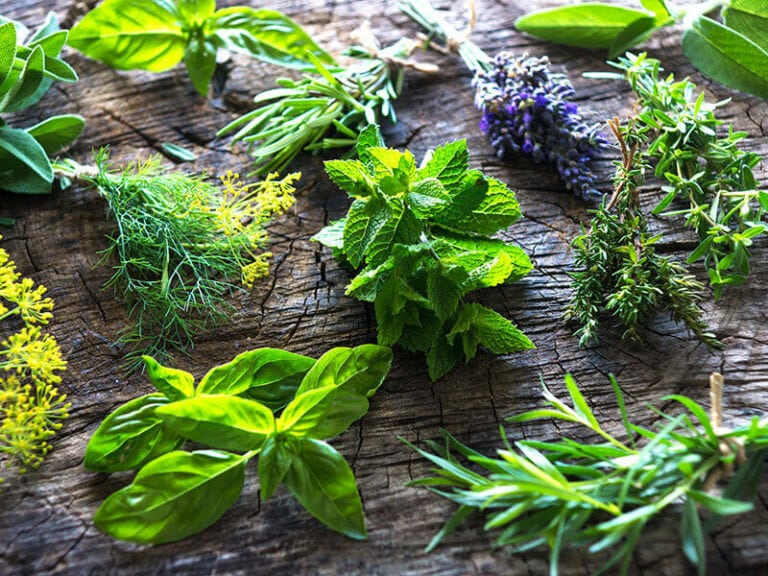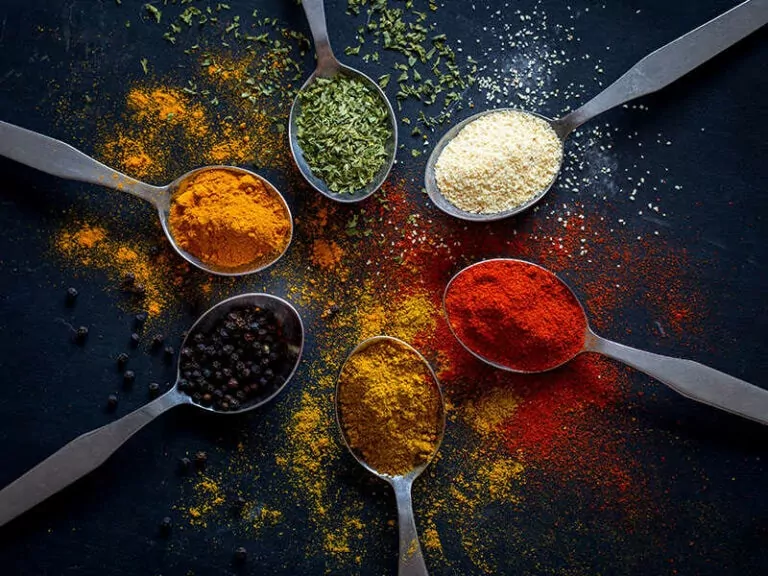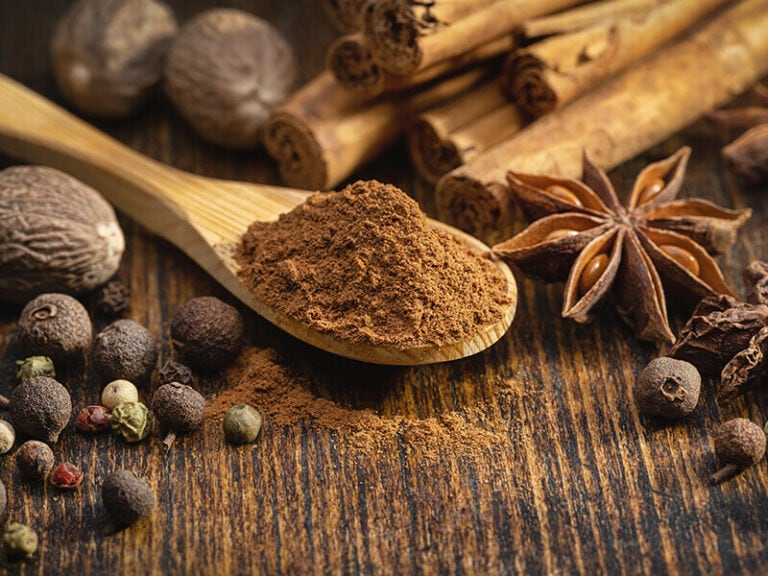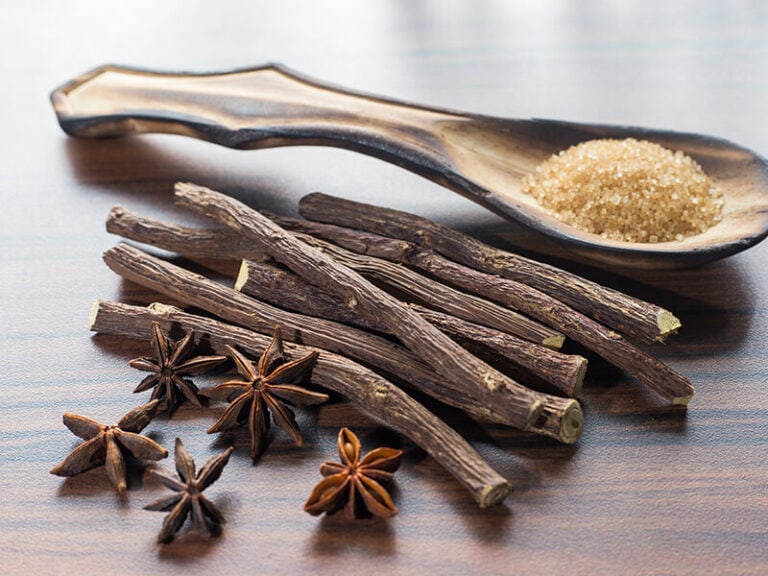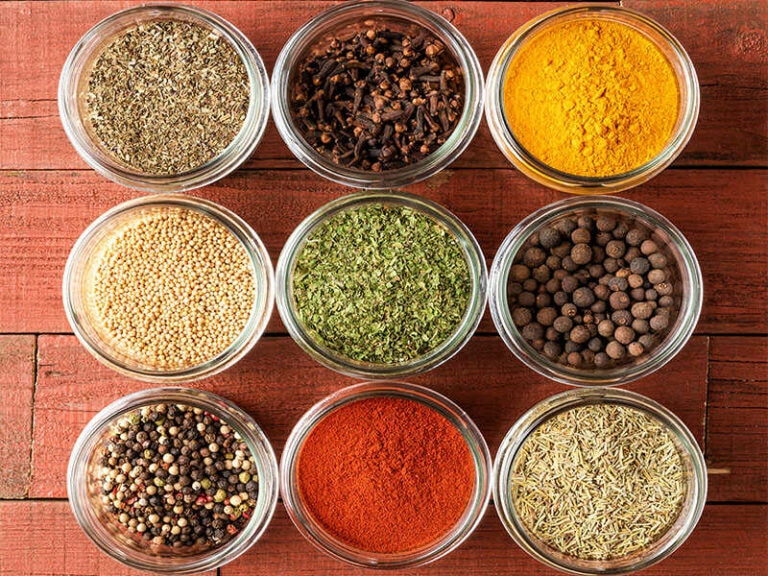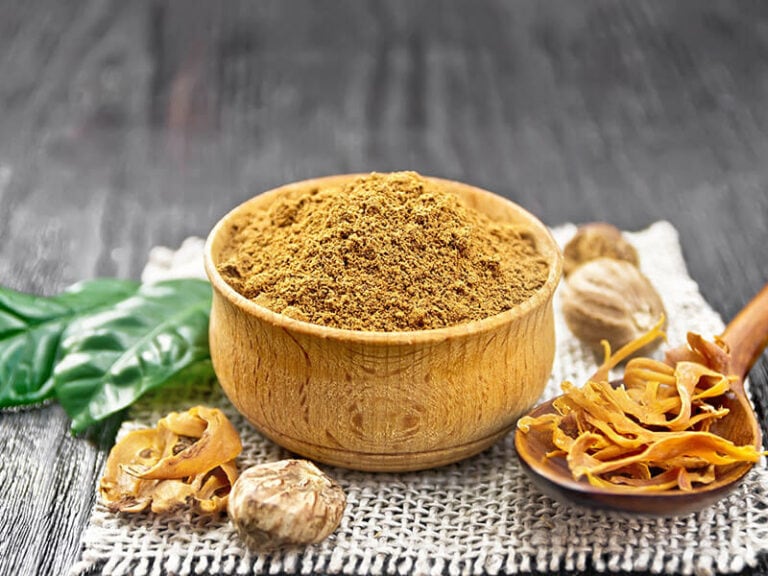If you’re looking for an excellent white pepper substitute, you’re in luck! Whether for a sudden lack of white pepper or the need to meet your new diet needs, finding a replacement can be rather tricky.
However, having a great idea of what to look for, you can make this a breeze and still nail your recipe in the best way. The good news is, there’re plenty of spices that you can use in place of white pepper.
Today, I’m walking you through the best white pepper substitutions and getting to know their flavors, benefits, and how to use them in replicating their spicy counterpart.
Get your apron, and let’s spice things up!
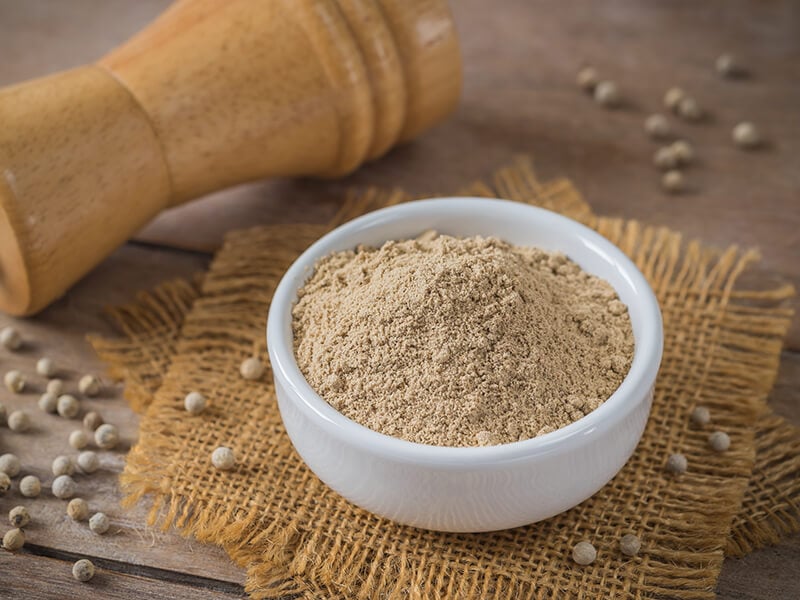
What Can I Use As A White Pepper Substitute?
Are you in a big hurry to get dinner on the table? If so, here’s my round-up of the best white pepper substitutes to help you finish up the last bits of those delicious recipes in a pinch.
1. Black Pepper
2. Green Peppercorn
3. Pink Peppercorn
4. Cayenne Pepper
5. Green Pepper/Chiles
6. Ground Ginger
7. Ground Mustard
8. Turmeric Powder
9. Paprika
10. Ground Cumin
11. Garlic Pepper
12. Seasoned Pepper Mix
13. Homemade Spice Blend
Fun Facts About White Pepper You Probably Didn’t Know
While less universally recognized than its black counterpart, white pepper is a key ingredient in many delicate dishes. These interesting white pepper facts will give you a good idea of what to look for in the right substitute.
What’s White Pepper?
It may surprise you that both white pepper and black pepper come from the same peppercorn plant, piper nigrum, which is a leathery-leaved vine that produces berries. The difference lies in how they’re harvested and processed.
While black peppercorns are picked before they’re ripe, white pepper is made from fully ripened berries. It’s then soaked in water, causing the outer skin to loosen and come off before being dried.
This process leaves the peppercorns with a smooth surface and a bright, sharper, and fruitier taste compared to black pepper, along with an earthy aroma. Though less complex in character, white pepper tends to have less intense heat since some are removed from the skin.
When To Use White Pepper?
Since white pepper offers a spicy, peppery bite minus the black specks; it’s mostly used in light-colored dishes and white sauces. This spice is a bigger star than its black counterpart in Asian cuisine, especially Chinese home cooking.
From marinades, creamy soups, chowders, and mashed potatoes, the options for white pepper seem to be endless. Beyond aesthetic appeal, it’s also praised for the complex yet subtle flavor profile added in recipes.
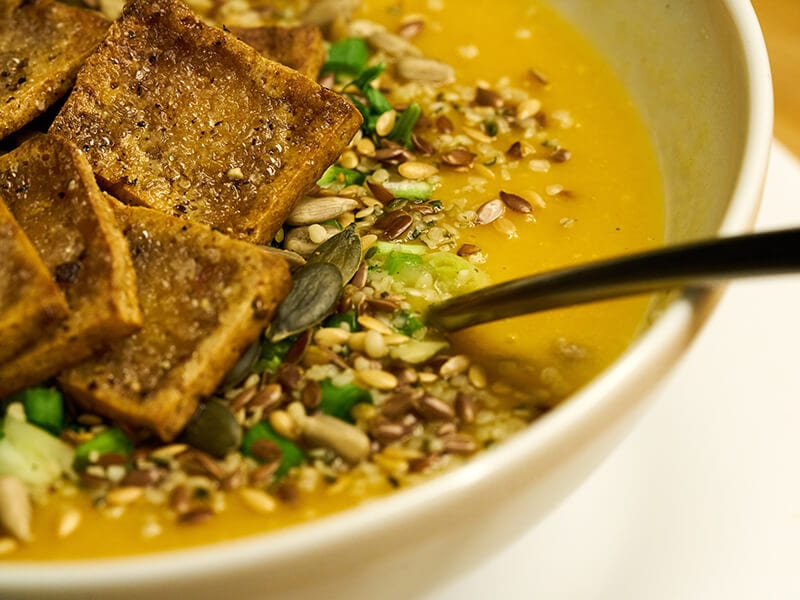
Health Benefits Of White Pepper
Did you know that besides its incredible culinary uses, white pepper also has tons of health benefits to offer? Consume it in moderation, which should be no more than 1-2 teaspoons per day, and this condiment is safe and exciting for your diet.
1. Helps Weight Loss
White pepper doesn’t contain saturated fat yet is packed with capsaicin, which helps burn the fats inside your body. Adding a small dose to your daily meals can boost your weight loss process and help you head towards a healthy diet.
2. Prevents Cancer
Thanks to the presence of capsaicin, white pepper has been shown to effectively counteract and kill cancer cells. Regular intake of this spice is also known for preventing prostate cancer and the occurrence of various cancers.
3. Stimulates Digestion
As with other spices, white pepper offers a good amount of fiber that helps with the secretion of gastric juices and prevents constipation. Plus, its carminative properties do a great job at preventing gas formation in your intestines and aid smooth digestion.(1)
4. Relieves Pain
If you have to experience the pain of sprains, spasms, or gout attacks, white pepper acts as an effective pain reliever and killer in a pinch. This is because its capsaicin properties generate heat in the affected area, which gradually lessens the pain.
5. Keeps A Healthy Heart
That’s right! Being hot, white pepper tends to make you sweat. This allows more expulsions of fluids from your body, thus enhancing its proper function. Flushing out the excess fluids also relieves the strains on your lungs, making breathing way easier.
6. Improves Eyesight
A natural remedy that’s been around for ages, white pepper improves the eyesight of people. With its rich vitamin content, you’re doing your eyes a favor just by eating a dash of white pepper regularly.
7. Aids Skin Exfoliation
There’re good reasons why white pepper is added in plenty of herbal facial packs. When freshly crushed, it works as an excellent exfoliator to slough off dead skin cells, cleanse your skin, increase blood flow, and reveal soft underlying skin afterward.
8. Strengthens Bones
White pepper possesses a rich content of minerals like magnesium, copper, and manganese. All of which contribute to improving your bone development and strength. This is especially beneficial for aging women over 40, whose bones begin to weaken over time.
9. Controls Blood Pressure
Due to the high level of flavonoids, vitamin A and C, white pepper is quite helpful in keeping your blood pressure under control. For people who have high blood pressure, adding spice to their daily diets might just be a great choice.
White Pepper Substitute Conversion Chart
When you’re unsure as to how much to substitute white pepper, have a quick look at my conversion chart. This way, it’s easier to ensure the success of your dishes every time.
| White Pepper Substitutes | Proportion |
| Black Pepper | 1 tsp white pepper = 0.5 tsp black pepper |
| Green Peppercorn | 1 tsp white pepper = 1 ½ tsp green pepper |
| Pink Peppercorn | 1 tsp white pepper = 1 tsp pink peppercorn |
| Cayenne Pepper | 1 tsp white pepper = ⅛ tsp cayenne pepper |
| Green Pepper/Chiles | Adjust to taste |
| Ground Ginger | Depending on your flavor |
| Ground Mustard | Add a small pinch |
| Turmeric Powder | Add slowly until meeting your taste |
| Paprika | 1 tsp white pepper = 1 tsp paprika |
| Ground Cumin | 1 tsp white pepper = ½ tsp ground cumin |
| Garlic Pepper | 1 tbsp dried parsley flakes + 4 ½ tsp powdered black pepper + 8 tsp garlic powder |
| Seasoned Pepper Mix | Adjust to taste |
| Homemade Spice Blend | 1 tbsp cayenne pepper powder + 1 tbsp black pepper + 1 tbsp paprika + 1 tbsp oregano + 1 tsp garlic powder + 1 tsp onion powder + 2 ½ tsp salt |
Top 13 Best White Pepper Substitutes For Your Recipes
Whether you wish to alter the heat or simply find the shaker empty in the middle of cooking, here are the most amazing white pepper substitutes you can get on your hands to nail that dish!
1. Black Pepper
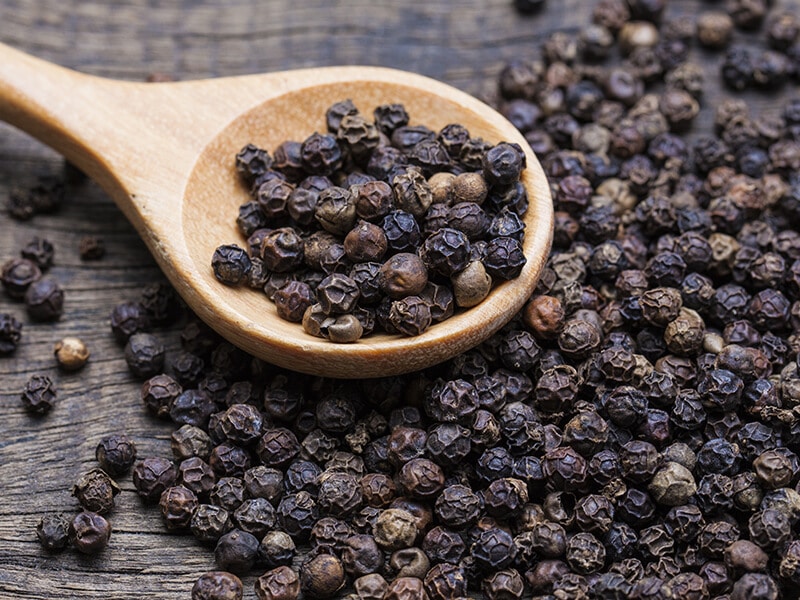
As black pepper comes from the same plant as the white type, it’s a close match in terms of flavor. Being the most commonly used seasoning on earth, chances are, black pepper is already lurking in that shaker on your spice rack.
Rich, sharp, and undeniably earthy, a dash of black pepper can bump up your meals. Due to its outer skin remaining while processed, it tends to have more spicy heat and a powerful aroma.
Thus, it’s best to use half the amount of black pepper as white pepper. Then, slowly cater the recipe to suit your palate and ensure the intense heat doesn’t overpower other flavors in the dish.
However, unlike its white counterpart, black pepper doesn’t blend in super well with light-colored dishes, which makes it tricky to whipping creamy sauces and soups.
But if you don’t mind a few black dots or specks on your plate, black pepper is a great sub to imitate the taste and aroma of white pepper.
If you need a guide to make some homemade crushed black peppercorns, you’re in the right place! Watch the video:
2. Green Peppercorn
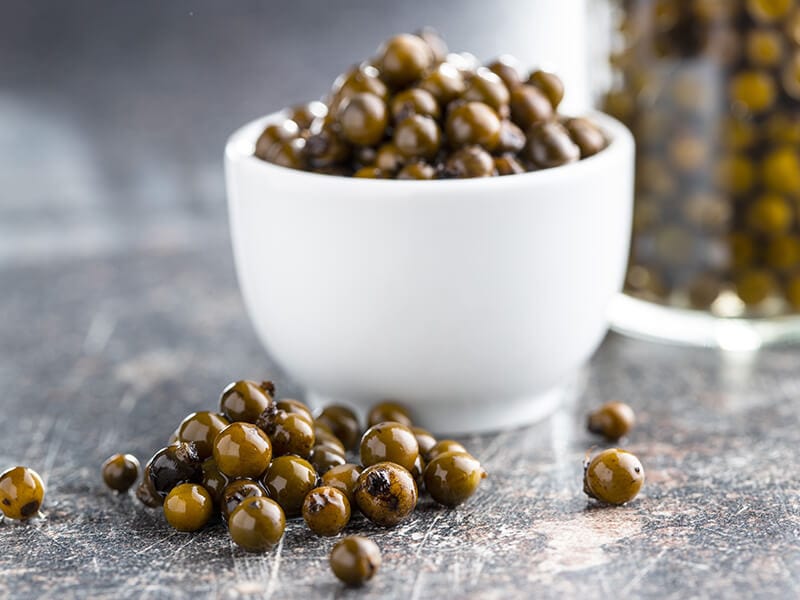
Another product of the Piper nigrum plant, green peppercorn, serves as a great white pepper substitute when you want to retain the visual appeal of light-colored dishes. You’ll love it in spreads, soups, and creamy pasta.
As opposed to black and white types, green peppercorns are harvested long before they mature. Since the berries aren’t allowed to ripen fully, they’re much less potent and spicy yet still add a touch of hotness into your recipe.
With a bright aroma and a fresh, fruity, mildly peppery taste, green peppers are the best bet for folks who can’t handle the heat and astringency of black and white ones.
Typically, you’ll find this spice in either dried or pickled form. Due to its mild potency, it’s best to add 1 ½ teaspoon of green peppers as an alternative for white peppers.
3. Pink Peppercorn
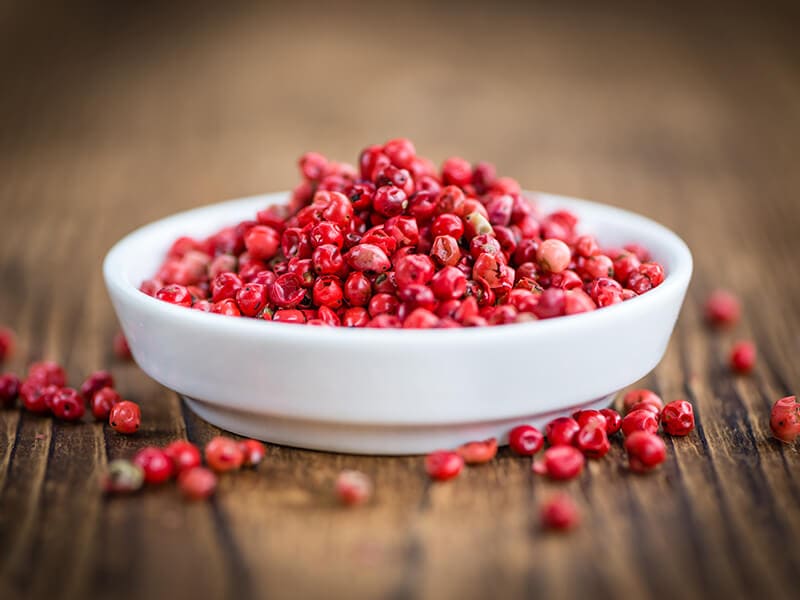
First of all, pink peppercorns aren’t peppercorns at all. Despite what the name might tell you, these are dried ripe berries of Brazilian pink pepper trees. They’re in the same size and shape as peppercorn varieties, hence the name.
To an extent, pink peppercorns somewhat resemble black peppers in flavor. However, they’re likely more delicate, sweet, and aromatic. The light peppery bite can enhance many buttery sauces, salads, seafood, and poultry courses.
What’s more, thanks to the rich, bold rose color, this condiment adds up to the elegant appearance that might make you fall in love.
Though normally harder to come by than other pepper varieties, these berries are great natural remedies to have on hand. Pop two or three bits in your mouth and chew when you have a cold, asthma, or cough.
My recommended ratio is to use the same amount of pink peppercorn as you would white. When cooking, you should add pink peppercorns towards the end, as excessive heat or a long cooking time might deteriorate their flavor.
4. Cayenne Pepper
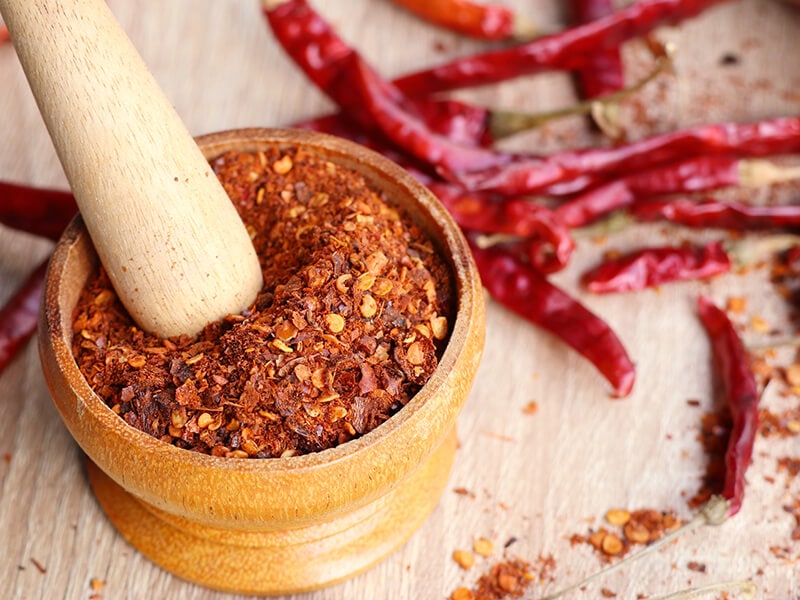
Let’s get it straight! Cayenne pepper is way spicier than white and black peppercorns. Rather than berries, this mighty spice comes from a real chili pepper plant like habaneros and habaneros.
While certain recipes require cayenne pepper, it’s mostly dried and ground into a fine powder. Best known for its primary role in Mexican home cooking, it’s used to flavor robust, spicy sauces, stews, as well as seafood and meats.
Heat-wise, most cayenne peppers score at 30,000-50,000 units on the Scoville scale. That’s about ten times hotter than jalapenos. It’s a family-friendly spice yet may create a burning sensation in your mouth if you’re sensitive to spice.
For folks who can take the heat, a pinch of cayenne pepper adds a fiery, earthy kick to your dishes. Also, its deep amber color blends well, bringing any dull or mild recipe to life.
When cooking, you may want to add less of this pepper than you would use for white peppercorns. The goal is to spice it up, not overtake or mute other flavors on the dish.
For best results, ⅛ teaspoon of cayenne pepper equals 1 teaspoon of white pepper. Then, feel free to add more to suit your liking.
If the heat seems more excessive than you can tolerate, a good tip for balancing out the too-hot flavor is using sugar and dairy products. Based on the flavor profile, honey and coconut milk also does the trick.
5. Green Pepper/Chiles
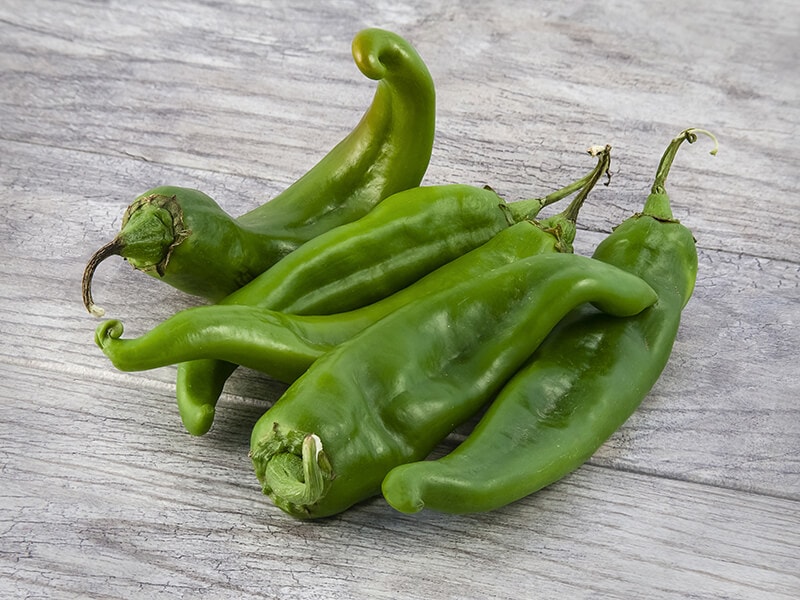
Green chiles are harvested young and unripe, which results in their tender texture and green color. The best way to describe how this variety tastes is a grassy, bright, earthy, and slightly pungent flavor.
With a mild spiciness similar to onions, green chilies make a fantastic substitution for white peppers in many applications. However, this heat level tends to range dramatically between different varieties.
One of the best things about these green chiles is that they can be eaten raw. And they’re absolutely delicious! That crispiness and spicy flavor can work up an appetite.
As a staple in Southern cooking, green chiles are featured in some of the most famous dishes. You can also roast or slow-cook them to bring out a smoky undertone and add depth to your meals.
Usually, the smaller the peppers, the hotter they are, and the milder the flavor. Though mostly consumed as a whole, these peppers are available in pickled and canned forms as well, so that you can always have some at hand.
Depending on the pepper’s spicy level and the type of dish, you can be flexible with the amount substituted. It’s always best to work little by little and add more to your liking as you go.
6. Ground Ginger
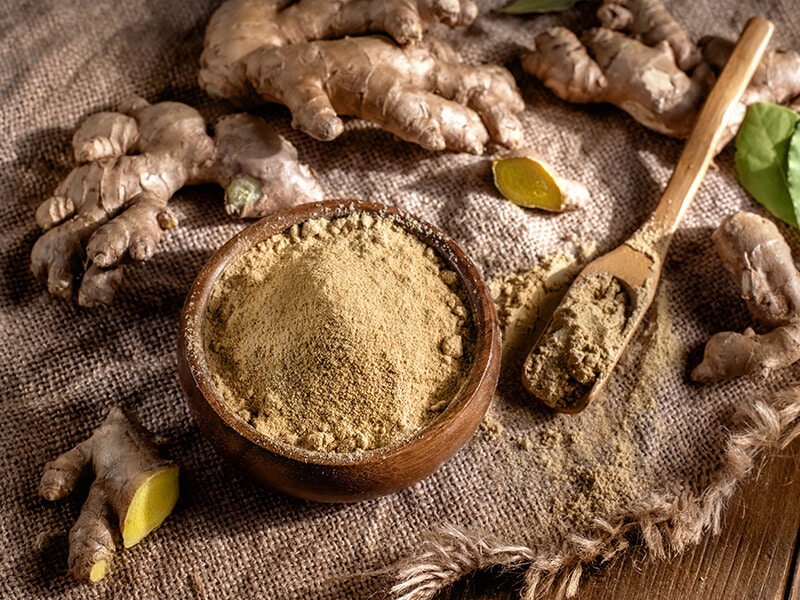
Visually, ground ginger is a fine powder that’s pale yellow in color. The spice blends so well into creamy dishes, creating a beautiful light color. Hence, it’s your best bet at replicating white, golden soups, sauces, and spreads without white pepper at hand.
Just a pinch of ground ginger lends a sweet, peppery, floral, and often with a hint of citrus. The flavor is much less pungent and spicy compared to white pepper, yet still adds warmth to meats and vegetables in your cooking.
Besides the taste, ground ginger is much appreciated for its medicinal benefits, thanks to the abundant source of fibers, essential vitamins, and minerals.
From relieving nausea to treating an upset stomach and reducing inflammation, ground ginger is a tried-and-true natural remedy for many health conditions. As far as dosage is concerned, an adult shouldn’t take more than 4 grams of ground ginger per day.
Keep in mind that a little ground ginger goes a long way, then you can work your way up to suit your palate. Depending on the recipe, one teaspoon or two would enhance your dish without overpowering it.
Making your ground ginger doesn’t get easier than this! Watch the video:
7. Ground Mustard
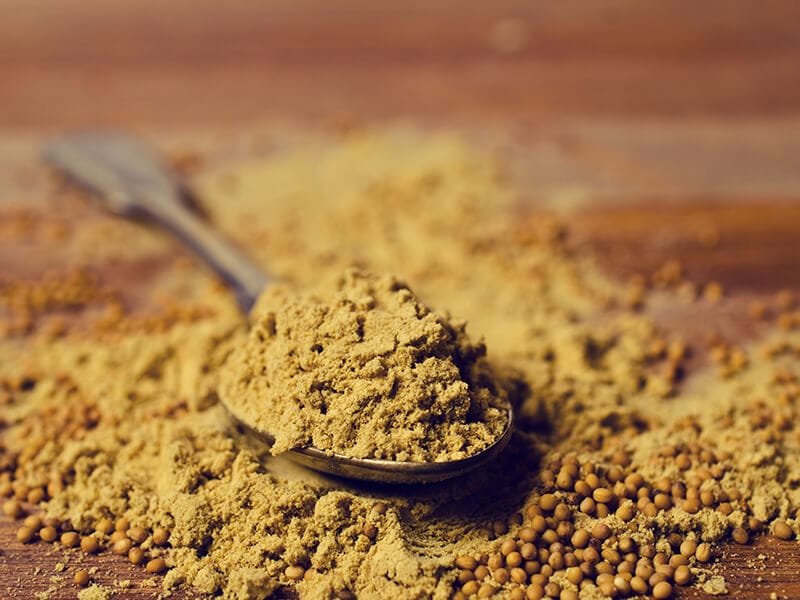
An easy-to-find condiment on most spice isles, ground mustard, or powdered mustard is possibly the most aromatic way to add tangy heat to your recipes. It’s usually made by grinding mustard seeds, resulting in a coarse texture.
By itself, ground mustard is merely tasteless. But when stirred into food, it brings out a fresh, clean fragrance that elevates your dish to the next level. It tends to become mildly spicy minus the lingering intensity that you get from white pepper.
Especially, the bright yellow color makes ground mustard a good fit for salad dressings, soups, sauces, baked goods, and other creamy dishes that lack complexity in flavor.
Besides boosting your meals, regular usage of powdered mustard offers a valuable source of protein, vitamin C, and fibers.
If you plan to replace dry mustard for white pepper, make sure to use a small pinch and slowly add more to achieve the desired result.
8. Turmeric Powder
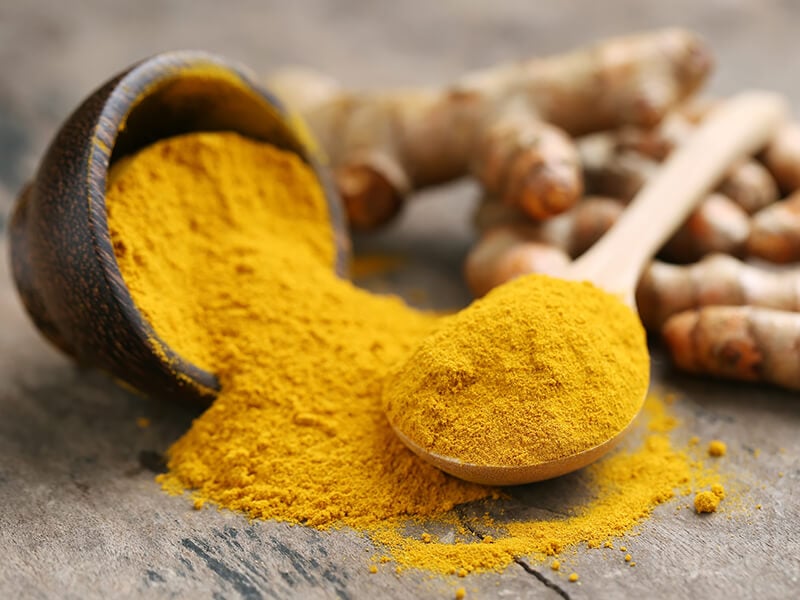
It’s no secret that turmeric powder has been an essential staple in Asian cooking for thousands of years. The earthy, slightly bitter, and mild peppery spices mingle well with rice and couscous, creating some of the most quintessential recipes.
As with ground ginger, turmeric powder serves as an excellent sub for white pepper, especially in creating colorful and picture-worthy dishes. Noted for its bright yellow color, this spice is used as a coloring agent for sauces and curries.
When it comes to working with turmeric powder, a little bit goes a long way. If you only have raw, fresh turmeric root, keep in mind that it tends to be more robust than its dried counterpart.
With loads of anti-inflammatory and antioxidant properties, this traditional Indian spice can protect your brain, heart and ward off illnesses such as Alzheimer’s and cancers.
Use it in curries for sure, but you can also toss it in with roasted veggies, soups, eggs, and even delicious smoothies. Considering its unique flavor, it’s best to start out with a little and work your way up.
Taking turmeric powder regularly can benefit your body! Watch the video:
9. Paprika
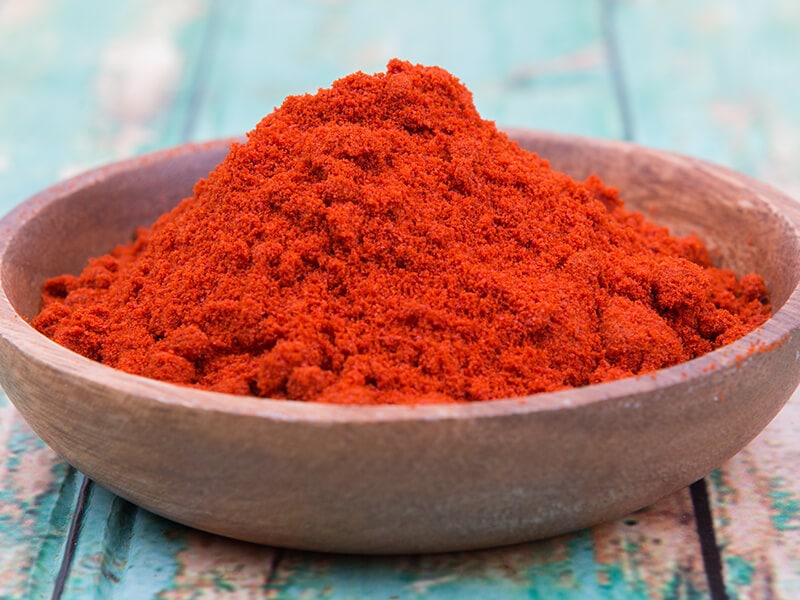
Another spice rack staple to use in place of white peppers, paprika, is meant to enliven your favorite dishes when used properly. In essence, it’s a chili powder made from several types of ground peppers.
There are good reasons why paprika is all the rage. You can find it in varying degrees of heat, ranging from sweet and barely spicy, mildly bitter, to fiery hot, depending on the type of peppers used.
You can’t go wrong with paprika. This ubiquitous condiment goes down beautifully with just about any savory food such as meats, poultry, and fish.
Since the seasoning comes in various heat levels, it’s best to be careful when substituting it for white peppers. If your paprika is sweet with no heat, try adding more than you would white peppers.
On the other hand, with hot paprika that packs the heat, work with the same amount as white pepper. For most recipes, it should be added near the end of cooking to prevent the flavor and color from being diminished.
Discover how to make your own paprika powder with one ingredient!
10. Ground Cumin
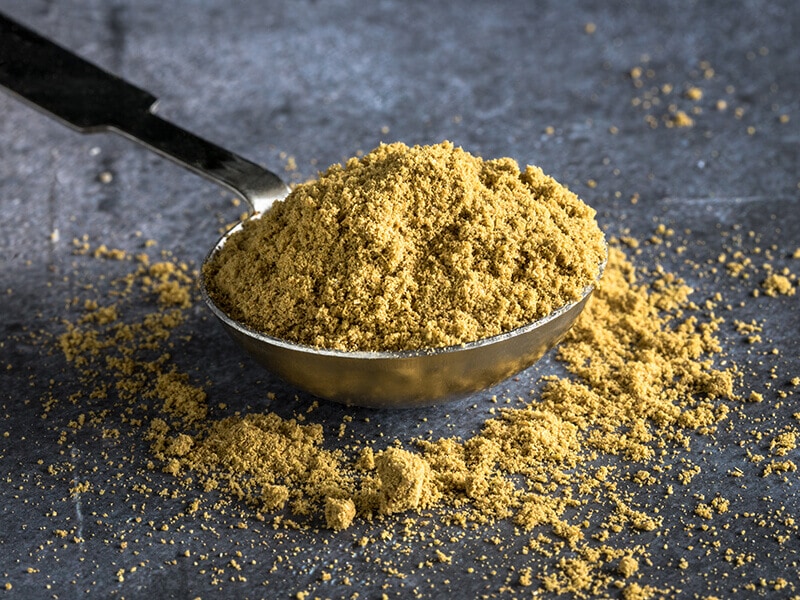
You may be surprised to hear that ground cumin is a wonderful replacement for white peppers. Rich, hearty, and earthy, with an edge of citrus, the spice instantly adds an extra dimension of flavor to any dish.
Essentially, cumin is produced from the dried seeds of the Cuminum cyminum plant, a member of the parsley family. The ground form allows it to disperse evenly. But you can also buy it as whole seeds.
Just to name a few, ground cumin is a key ingredient in tons of spice blends like curry powder and taco seasoning. It’s a delicious match for meat as well as vegetable dishes. Try it in your next hamburger!
In the sense of heat, the taste of cumin is peppery and slightly hot. Ground cumin has just a bit more heat than sweet paprika, which makes it perfectly fine to introduce to your whole family.
As with other strongly flavored seasonings, cumin can obliterate other flavors on the dish if too much is used. Replace half a teaspoon of ground cumin for every teaspoon of white pepper. You can always add more later.
11. Garlic Pepper
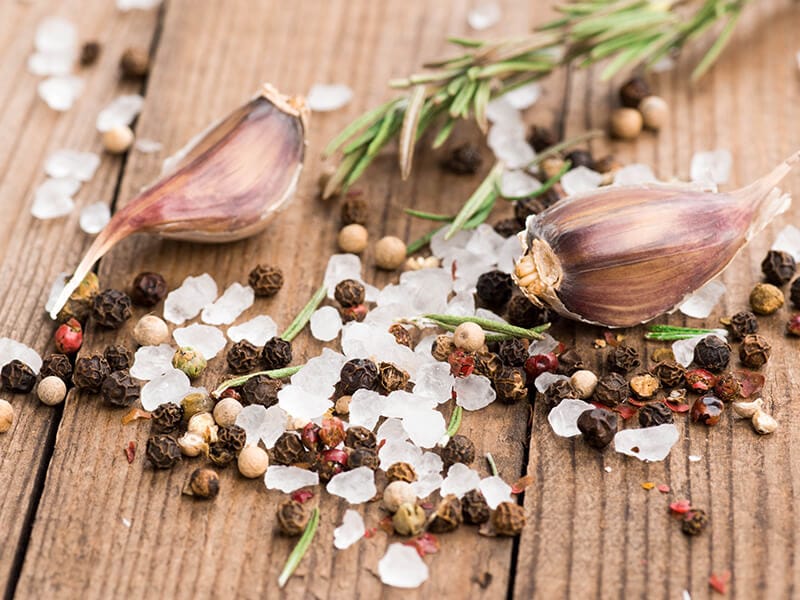
As its name suggests, garlic pepper is a blend including black peppers, garlic, and other dried spices. This robust condiment has a complex and balanced flavor. Neither too spicy nor garlicky, it’s used to flavor all kinds of your favorite food.
Most people like garlic pepper best in marinades, soups, and salad dressings. Flavor-wise, it’s so distinctive and versatile, you’ll probably be reaching for it every day.
While some versions are a simple mix of the two popular spices, others integrate added seasonings like onions, bell peppers, parsley, and sugar. If you’ve got time, don’t be shy to try a few and find out the best one that suits your palate.
Garlic pepper can be a game-changer when regular meals get boring. Besides adding a wonderful depth and spice, it also saves time with an array of flavors all in one.
You can find bottles of garlic pepper in most spice aisles, or combine a simple mix using this suggestion:
- 1 tablespoon of dried parsley flakes
- 4 ½ teaspoons of powdered black pepper
- 8 teaspoons of garlic powder
12. Seasoned Pepper Mix
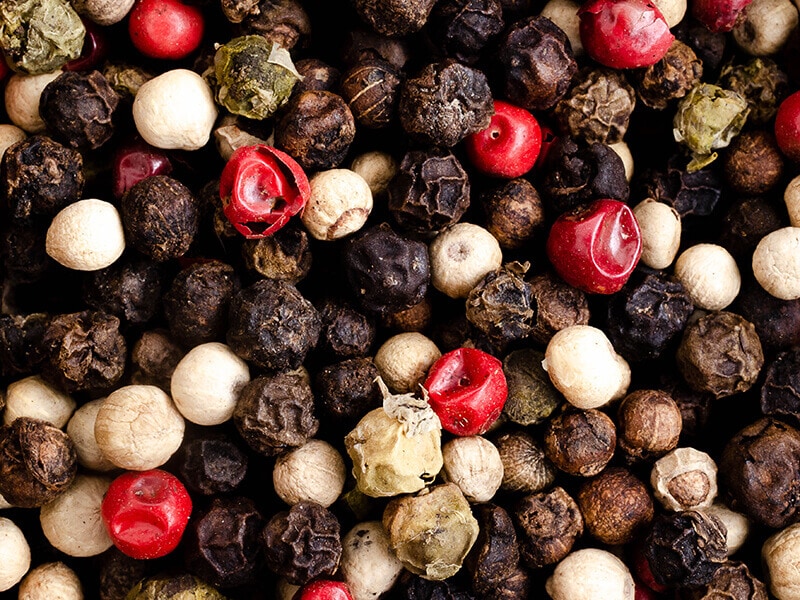
Are you seemingly bored of the same old meals every day? Turn to a seasoned pepper mix to shake things up and take your taste buds on an adventure. This delectable condiment often consists of black peppers, red bell peppers, and added spices.
Thanks to its diverse ingredients, a pepper mix offers a flavorful and complex taste. Most variations are low on sodium, which makes a great fit for those who are on a sodium-free diet.
You can add a pop of it to just about anything, from poultry and meat to seafood. Or else, lightly sprinkle it as a finishing touch to your mashed potatoes and toasts. The zip of flavor and mild spice should take your plain meals to the next level.
Walking down the spice aisle, you’ll find lots of seasoned pepper mixes with different heat levels. Keep in mind to check these ingredients carefully and make sure it works best for you.
13. Homemade Spice Blend
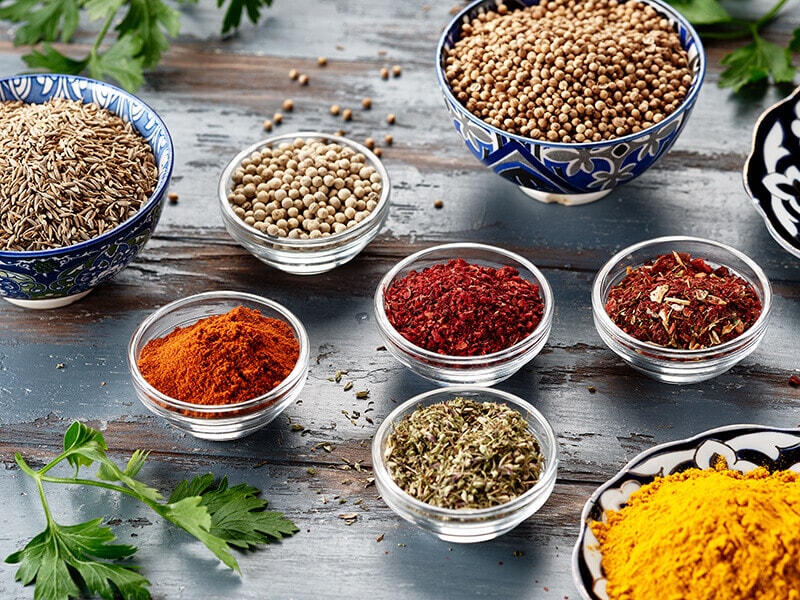
Creating your very own spice blend at home is a win-win idea. Not only does it add an exotic pop of flavors to your recipes, but it also minimizes your intake of prepackaged food.
For home cooks with an assortment of spices and herbs in your pantry, making a DIY seasoning blend should be a breeze. To substitute white peppers, simply combine a mix of chili powder, paprika, black pepper, garlic powder, cumin, and salt.
Try new flavors and cater the ratios to your taste. Do a little bowl if you’re preparing just enough for one recipe. However, stacking a bottle of your own spice mix can take a lot of guesswork out of cooking every next time.
A good combination of homemade blend may involve:
- 1 tablespoon of cayenne pepper powder
- 1 tablespoon of black pepper
- 1 tablespoon of paprika
- 1 tablespoon of oregano
- 1 teaspoon of garlic powder
- 1 teaspoon of onion powder
- 2 ½ teaspoon of salt
Why skip that mild spiciness when you can have yourself the perfect peppery blend even without white pepper? Soon enough, you’ll want to put it in marinades, salads, stews, and all the dishes that you enjoy anytime your white pepper is all out.
For the best quality, in the long run, it’s essential to store your seasoning blend in an airtight container. Keep it in a dark, cold, and dry place, just as with other spices.
Try out these different homemade spice blends and see what works best for you!
Top-Rated White Pepper Recipes For Your Home Cooking Arsenal
If you need inspiration for meal ideas with white pepper, I have some special treats for you. Save these crowd-pleasing recipes to impress everyone around the table!
1. Croque Madame
Croque madame is a French bistro classic for good reasons. Simply put, it’s a hot sandwich starring layers of melted cheese and thinly sliced ham between thick, audibly crunchy slices of white bread.
A touch of white pepper is the perfect addition to the béchamel drenched on the sandwich. This traditional treat is a treasure trove of texture. Each bite is so gooey, creamy, and crispy to satisfy your taste buds.
2. Hollandaise Sauce
An essential element of breakfast fares, hollandaise sauce is a culinary delight at its finest. This simple, savory sauce is an emulsion of egg yolks, butter, salt, and lemon. Ground white pepper gives it a good kick, while the bright note of lemon keeps it from being too heavy.
No doubt, hollandaise sauce is a match made in heaven with eggs benedict. However, you can use this foolproof recipe for so much more than that, such as dressing up veggies or spooning it over fish for a fabulous homemade brunch.
3. Baked Potato Soup
Delectable and simple to make, creamy potato soup is pure comfort food in one bowl. The rich, cheesy, and oh-so-fragrant flavor is meant to warm your belly and soothe your soul when it gets chilly outside.
Combine potatoes, onions, white pepper, broth, and all your favorite toppings in the pot. Bring the whole thing to a gentle boil then let it simmer on the stove. 15-20 minutes in, you’ve got yourself the best low-budget, healthy weeknight meal ever.
4. Broiled Lobster Tails
Nothing screams a better easy but fancy recipe than broiled lobster tails. It’s probably the best way to cook lobster tails, and is only a few minutes away if you’re pressed on prep time for dinner.
Buttery, succulent lobster tails seasoned with salt and a sprinkling of white pepper allows the fresh lobster meat flavor to shine through. You can pair this dish with some baked potatoes, butter, and a dollop of sour cream for an elegant dinner at home.
Frequently Asked Questions
Finding the right white pepper substitution can be a cinch as long as you know what you’re looking for. Stick around for more interesting facts that’ll clear some myths on this spice.
Cook To Perfection Even Without White Pepper!
Whether you’re in the middle of a recipe and suddenly realize you’re missing white pepper or want to shake things up to fit your special diet needs, you now know what to swap in!
Most of these substitutes are readily available in your spice rack, while others need you to walk down the spice aisle. In a pinch, just use what works best for your recipe. You shouldn’t be worried about messing it up because you won’t.
If it’s your first attempt at substituting the spice, a little goes a long way. Work with a small amount and taste as you go. This way, it stands no chance at overpowering other flavors in your dish.
For folks who want extra warmth and earthiness, paprika and turmeric powder are your best bet. Meanwhile, if you can take the heat, opt for cayenne and black peppers instead. It’s up to you to find the best-suited spice for your palate.
What’s your favorite white pepper substitution off the list? Is there a near and dear spicy recipe you’re most passionate about? Jot it down in the comment and let me know!
References
- En.wikipedia.org. 2021. Carminative – Wikipedia. [online] Available at: <https://en.wikipedia.org/wiki/Carminative>

